Simultaneous Analysis of Water- and Fat-Soluble Vitamins

Growing health consciousness has inundated the market with an ever-expanding array of vitamins, supplements, and sports nutrition products intended to boost the diet with nutrients not adequately consumed in foods. Manufacturers need to quantify vitamin content not only to differentiate products’ value but also to meet regulatory and labeling requirements.
The 13 “essential” vitamins are common ingredients in health and nutrition products. Getting sufficient intake of essential vitamins insures overall health and well-being, proper metabolism, immune response, and numerous other functions in the body. Vitamins are classified as either “water-soluble” or “fat-soluble.” Water- and fat-soluble vitamins not only act differently within the body but also require different methods to analyze effectively due to their dramatically different hydrophobicities and solubilities.
Water-Soluble Vitamins (WSVs):
• Thiamine (Vitamin B1)
• Riboflavin (Vitamin B2)
• Nicotinamide/Nicotinic Acid (Vitamin B3)
• Pantothenic Acid (Vitamin B5)
• Pyridoxine/Pyridoxal Hydrochloride (Vitamin B6)
• Folic Acid (Vitamin B9)
• Cyanocobalamine (Vitamin B12)
• Ascorbic Acid (Vitamin C)
Fat-Soluble Vitamins (FSVs):
• Retinol (Vitamin A)
• Tocopherol (Vitamin E)
• Calciferol (Vitamin D)
• Antihemorrhagic Vitamins (Vitamin K)
In the body, water-soluble vitamins dissolve quickly and are carried to tissues but cannot be stored in them. Fat-soluble vitamins, on the other hand, are absorbed in fats and carried to the small intestines and then into the bloodstream. Unlike water-soluble vitamins, fat-soluble vitamins are stored in the body in the liver and tissues.
The Challenges of Simultaneous Analysis of Vitamins
In the laboratory, reverse-phase liquid chromatography is a popular technique for vitamin analysis due to its general simplicity and cost-effectiveness. It is extremely versatile due to the wide range of solvents (mobile phases) that can be used. WSVs require an aqueous mobile phase with a low-organic solvent content, whereas FSVs require highly organic solvent mobile phases. The different types of mobile phases required is due to the different solubility and reverse-phase retention properties of WSVs and FSVs.
Given the disparate mobile phases required to analyze WSVs and FSVs, developing a reverse-phase method for the simultaneous analysis of both WSVs and FSVs has been a challenge. Traditionally, either separate or sequential analyses have been required, which have inherent drawbacks that make accurate quantification of vitamin content either time-consuming or overly complex. While numerous workflows have been devised over the years to analyze both WSVs and FSVs, the overview below compares three approaches devised to streamline both WSV and FSV analysis in a single run or simultaneously.
Workflow Strategies
One workflow was devised where two reverse-phase high-performance liquid chromatography (HPLC) columns ran sequential analyses on a single liquid chromatography (LC) system.[1] For this approach, a conventional LC system was fitted with a pair of switching valves to connect each HPLC column to an injector and ultraviolet (UV) detector. While the method did allow analysis of both vitamin classes with unattended operation, it required a complex hardware setup and even more complex chromatography data system programming. Additionally, since the HPLC columns were run one after the other, throughput was low.
A second workflow was developed using a single HPLC column to separate both WSVs and FSVs. It required a three component, multi-step mobile phase gradient program with delayed injection of the sample expected to contain FSVs.[2] This way, the highly hydrophobic FSVs entered the column only when the strength of the mobile phase was sufficiently high. The method was dependent on the flexibility of the chromatography data system and LC system. While this approach allowed simultaneous analysis of WSVs and FSVs, the complexity of programming and instrument setup made it somewhat cumbersome. In addition, this workflow ran different mobile phases in a shared flow path which introduces the possibility of cross-contamination.
Finally, a third workflow overcomes the challenges of two previously approaches. It is based on a novel “dual” LC system that contains two pumps with two independent flow paths, two separate injection ports, and two detection systems. It enables the independent yet concurrent use of two different HPLC columns and methods.[3] The advanced features of this system allowed development of separate methods specifically optimized for FSVs and WSVs to be run simultaneously without modification to the system. The “dual” workflow delivered much higher throughput compared to the column switching approach mentioned in the first example above.[1] It also avoids potential mobile phase incompatibility issues caused by the shared flow path of the second example mentioned above.[2] In addition, this approach was extremely simple to implement due to built-in features of the system.
Advantages of Dual HPLC Workflow
• Ease of setup
• Methods optimized for both WSVs and FSVs
• Elimination of potential cross contamination of mobile phases
• Increased throughput and faster analysis
More about Vitamin Analysis with Dual HPLC
For complete details on how dual HPLC can be used for simultaneous analysis of both WSVs and FSVs in both vitamin tablets and energy drinks, be sure to read this application note.
Learn more at ThermoFisher.com.
References
1. Thermo Fisher Scientific Technical Note 72488: Determination of water- and fat-soluble vitamins by HPLC.
2. Thermo Fisher Scientific Application Note 252: HPLC Assay of Water-Soluble Vitamins, Fat-Soluble Vitamins, and a Preservative in Dry Syrup Multivitamin Formulation.
3. Thermo Fisher Scientific Application Note 72592: Simultaneous Determination of Water- and Fat-soluble Vitamins in Tablets and Energy Drinks by Using a Novel Vanquish Duo system for Dual HPLC.
Looking for quick answers on food safety topics?
Try Ask FSM, our new smart AI search tool.
Ask FSM →







